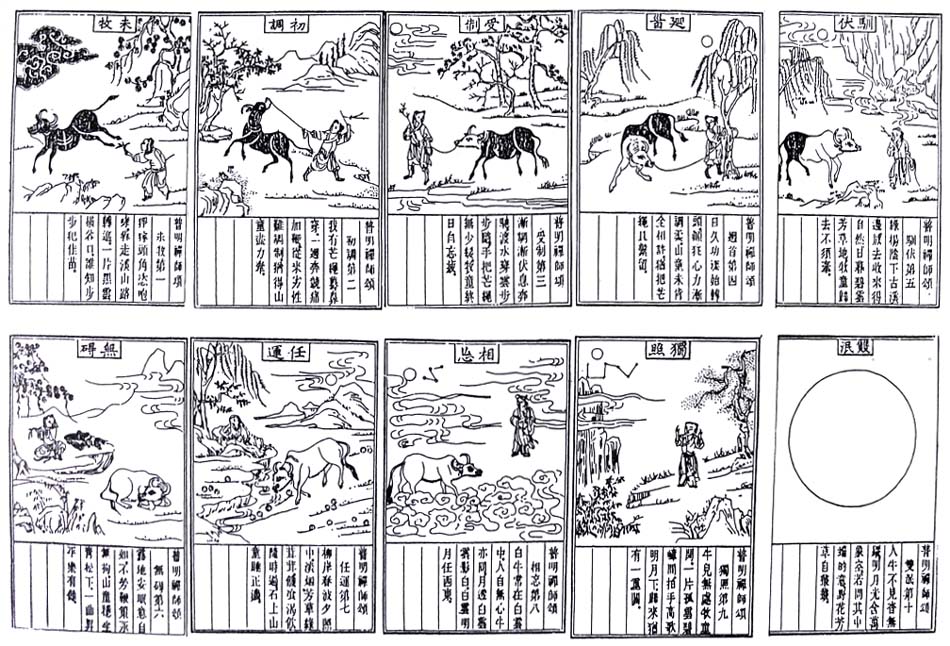ZEN IRODALOM ZEN LITERATURE
« Zen index
« Home
十牛圖 Shiniu tu [Jūgyūzu]
The Ten Oxherding Pictures
Verses by 普明 Puming

P'u Ming's Oxherding Pictures & Verses
Empty Bowl Press, Port Townsend, WA, 1983; 1987; 2011, 28 pages.
[translated] by Red Pine [Bill Porter, 1943-]
(Translations have been removed at the request of copyright owner.)
http://www.mediafire.com/view/pag9570a1l9rf3d/Puming-Oxherding.pdf
[An excerpt from the preface of Red Pine:]
No one knows who P'u Ming was or when he wrote these verses
or whether he's also responsible for the accompanying woodblock
pictures. The earliest edition available to us was published by Chu
Hung in 1609. Despite being one of the most knowledgeable
monks of the sixteenth century, Chu Hung didn't know who P'u
Ming was either. The consensus among scholars is that he wasn't the
fourteenth-century monk of the same name noted for his paintings
of bamboos. In any case, P'u Ming's weren't the only oxherding
pictures around. And they certainly weren't the first. There were at
least three earlier sets of oxherding pictures by three Sung dynasty
(960-1279) monks; a series of five pictures by Ch'ing Chu, one of
six pictures by Tzu-te Hui and a set of ten pictures by K'uo An.The pictures by Ch'ing Chu and Tzu-te Hui showed the ox
gradually becoming whiter until both it and the herdboy finally
disappeared in the fifth picture, which consisted of a circle. To this,
Tzu-te Hui added a sixth picture showing the boy returning to the
world, unattached. This was meant to point the viewer beyond the
emptiness that the circle seemed to imply. But this improvement
must have reminded P'u Ming of the man in the snake drawing
contest. Finishing his drawing before his competitors and not
knowing what to do, the man idly added feet to his snake and lost.
Hence, P'u Ming chose not to follow Tzu-te Hui's example. Instead,
he ended his series, as Ch'ing Chu had done, with the circle of
light. Also, by expanding Ch'ing Chu's earlier five pictures into ten,
he provided a commentary to one of the most popular Buddhist
concepts, the ten paramitas, or means to the other shore: charity,
morality, patience, devotion, meditation, wisdom, works, vows,
power and knowledge.[...]
The origin of the oxherding metaphor can be traced to this
injunction delivered to the Assembly by the Buddha the night of his
Nirvana, "Monks, once you're able to keep the precepts, you should
prevent your five senses from indulging in the five desires. Be like
the herdboy with his staff in hand who watches over his ox and
keeps it from running through grain fields." (Testament Sutra)[...]
1. UNTAMED
詠未牧
生獰頭角恣咆哮 犇走溪山路轉遙
一片黑雲橫谷口 誰知步步犯嘉苗1. UNTAMED
a raging ox with menacing horns
runs away across hills and streams
where black clouds shroud the valley
who know what sprouts lie crushed
2. TAMING BEGUN
從來劣性難調制 猶得山童盡力牽2. TAMING BEGUN
suddenly my rope is through its nose
it tries to run but I use the switch
a willful nature is hard to tame
a boy must pull with all its might
3. RESTRAINED
手把芒繩無少緩 牧童終日自忘疲3. RESTRAINED
gradually tamer the ox calms down
through water and clouds it follows in step
holding the rope perfectly taut
the herdboy forgets he's tired
4. TURNING ITS HEAD
山童未肯全相許 猶把芒繩且繫留4. TURNING ITS HEAD
constant effort brings the ox roung
its wild heart in time grows mild
a mountain boy can't rest yet
he holds the rope or leaves it tied
5. TAMED
日暮碧雲芳草地 牧童歸去不須牽5. TAMED
in willow shade by an ancient stream
the herdboy gives the ox free rein
from dusk blue clouds and sweet grass fields
he leads it home untied
6. UNHINDERED
山童穩坐青松下 一曲昇平樂有餘6. UNHINDERED
dozing in the open the ox is at peace
no more need for the rope or switch
the boy sits serene below green pines
content with a pastoral tune
7. WITH THE CURRENT
柳岸春波夕照中 淡烟芳草綠茸茸 饑食渴飲隨時過 石上山童睡正濃7. WITH THE CURRENT
willow bank and spring flood in twilight
fine mist and lush green grass
the ox eats and drinks when it wants
the boy sleeps soundly on the rock
8. FORGETTING THE OTHER
月透白雲雲影白 白雲明月任西東8. FORGETTING THE OTHER
the white ox stays inside white clouds
like the boy its mind is blank
shadows of the moon through white clouds are white
clouds go east the moon goes westNote upper left corner:
The four stars, together with nearby Vega, form the constellation
Lyra in Western astrology. Vega is known to the Chinese as the
Spinning Maid Star and is paired with the Herdboy Star, Altair in the
constellation Aquila. But the two only see each other on the
Seventh day of the Seventh Moon, when all the magpies on
Earth fly up to Heaven and form a bridge across the Milky Way.
9. ALONE IN THE LIGHT
拍手高歌明月下 歸來猶有一重關9. ALONE IN THE LIGHT
one lone cloud among the peaks
the ox is gone the herdboy free
beneath the moon he claps and sings
one more pass to goNote upper left corner:
Just as the sauvastika 卍 becomes the svastika 卐 when viewed
from the other side, the Big Dipper, the turning sauvastika in the
sky, appears here as seen from the Other Shore.
10. BOTH GONE
若問其中端的意 野花芳草自叢叢10. BOTH GONE
of ox and boy there's no trace
moonlight holds a world of space
around who asks what this means
wild flowers and sweet grass grow